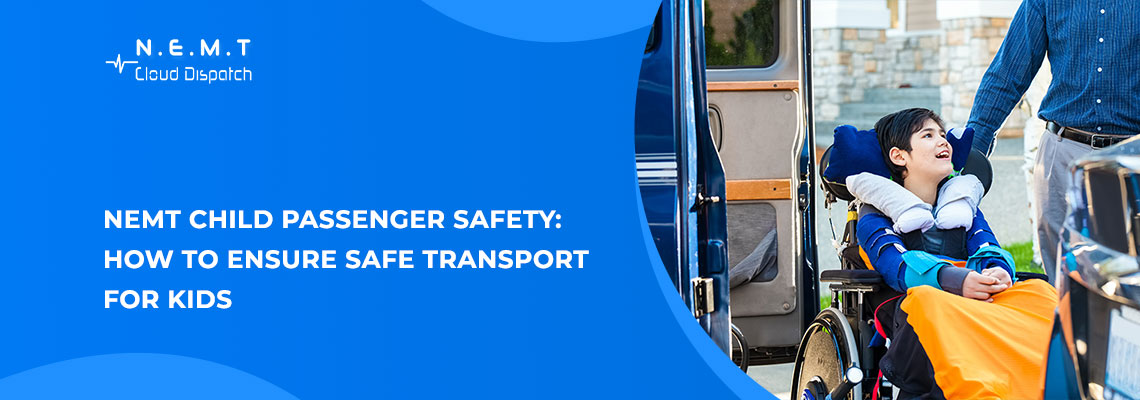Non-emergency medical transportation (NEMT) is a vital service that ensures patients with mobility challenges and specific medical needs have access to transportation. While most NEMT companies focus on adults as their primary demographic, child safety in Non-Emergency Medical Transport is often overlooked.
However, children, especially those with medical conditions, deserve the same level of safety and comfort during their NEMT journeys.
NEMT Cloud Dispatch will cover everything you need to know about child passenger safety in NEMT operations. Including best practices, compliance requirements, and additional services tailored for children.
Exploring Child Passenger Safety in NEMT Operations
NEMT services are critical for children who require regular visits to healthcare providers for medical treatments, therapy, or specialized care. It’s much safer for children with medical. Developmental needs to travel using NEMT services rather than relying on public transportation.
How NEMT Enhances Rural Healthcare Delivery also emphasizes the importance of reaching all demographics, including children, especially in underserved areas.
Challenges in Child Passenger Safety
Most NEMT providers prioritize adult passengers, and their vehicles are primarily equipped for:
- Ambulatory patients
- Wheelchair users
- Stretcher accommodations
However, NEMT companies must also include child-specific safety measures in their operations. According to the Insurance Institute for Highway Safety (IIHS), 715 children lost their lives in motor vehicle crashes in the U.S. in 2021.
A significant portion of these tragedies involved unbuckled children, highlighting the importance of proper restraints.
NEMT providers need to ensure their vehicles are equipped with appropriate, safe transport for children in NEMT features to minimize risks during transportation.
For example, when deciding on appropriate equipment, it’s important tounderstand the differences between stretchers and gurneys, which can help inform the choice of equipment for transporting children safely.
Essential NHTSA and AAP Guidelines for Child Transportation in NEMT
The National Highway Traffic Safety Administration (NHTSA) and the American Academy of Pediatrics (AAP) have issued specific guidelines for child transportation, particularly for vehicles providing services like NEMT.
NHTSA Recommendations
• Side-Impact Airbags: Protect children in case of collisions.
• Child Safety Locks: Prevent children from accidentally opening doors during transit.
• Anti-Pinch: Windows Automatically reverse if they detect resistance, preventing injuries to children.
• Secure Seatbelts: Designed to accommodate child safety and booster seats.
AAP Recommendations
• Rear-Facing Seats:Infants and toddlers up to 2 years old must use rear-facing seats.
• Forward-Facing Seats:Children aged 2+ who outgrow rear-facing seats should use forward-facing seats with a harness.
• Booster Seats:Older children (typically 8–12 years old) may require a booster seat until they reach a height where seatbelts fit properly.
• State Regulations: Since NEMT operations are state-regulated, companies must also comply with state-specific guidelines for transporting children.
NEMT Providers’ Responsibility for Child Safety Seat Compliance
Child passenger safety is not optional. Every NEMT company has a legal and ethical responsibility to ensure they meet safety standards when transporting children. Vehicles must carry child safety and booster seats and ensure they are properly maintained.
Drivers must be trained to secure these seats correctly. Drivers should possess the skills to handle children safely and be able to create a welcoming environment. NEMT providers must cater to families, ensuring they do not deny services to children or individuals traveling with children.
How Technology Can Help NEMT Companies
Modern NEMT software solutions, such as NEMT cloud dispatch, enable providers to integrate child safety seamlessly into their services.
Key Features of NEMT Software for Child Passenger Safety:
- Vehicle Selection: Matches trips with child-friendly vehicles equipped with required safety features.
- Driver Assignment: Assigns drivers trained in transporting children and ensuring safety compliance.
- Fleet Management: Maintains a log of safety equipment and schedules timely maintenance for vehicles.
By adopting technology, NEMT companies can streamline operations while prioritizing the safety and comfort of child passengers. Beyond medical appointments, NEMT services can cater to student transportation and other specialized needs for children:
Ensures a safe, stigma-free transit environment for children with developmental challenges. It offers a safer alternative to traditional school buses. Provides transportation for children attending counseling or therapy sessions.
Child Passenger Safety in NEMT: Essential Provider GuidelinesConclusion
Safety should never be an afterthought, especially when transporting children. NEMT providers play a crucial role in ensuring every journey is safe and comfortable.
By adhering to guidelines, equipping vehicles with proper safety features, and training drivers, NEMT companies can protect their youngest passengers while fostering trust and reliability.
With technology likeNEMT cloud dispatch, NEMT providers can efficiently cater to the unique needs of children, ensuring that they reach their destinations safely and on time.


